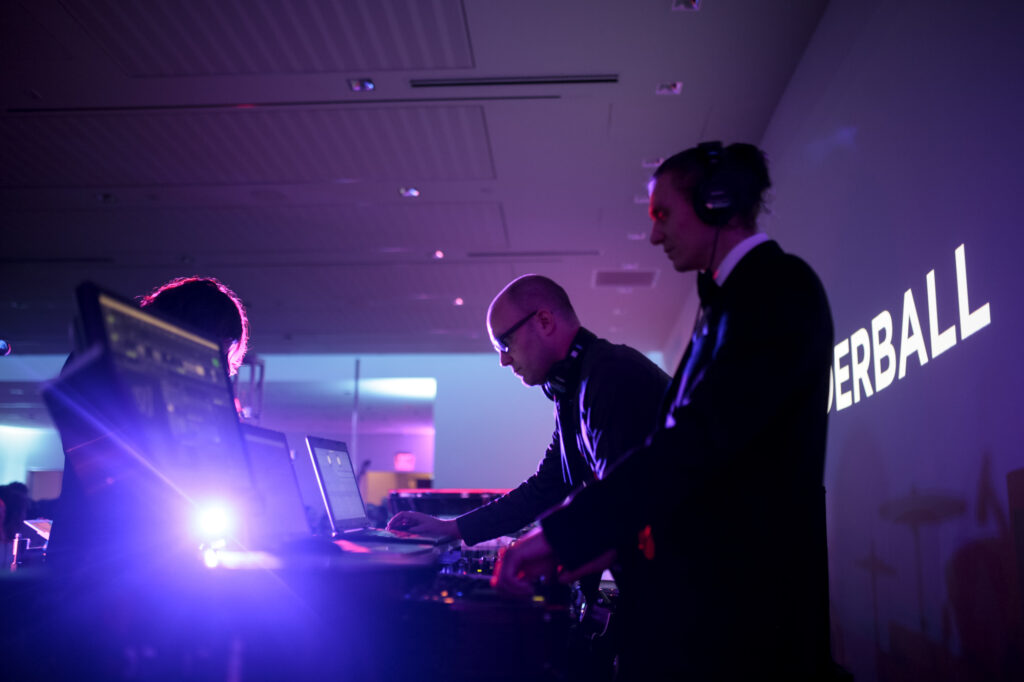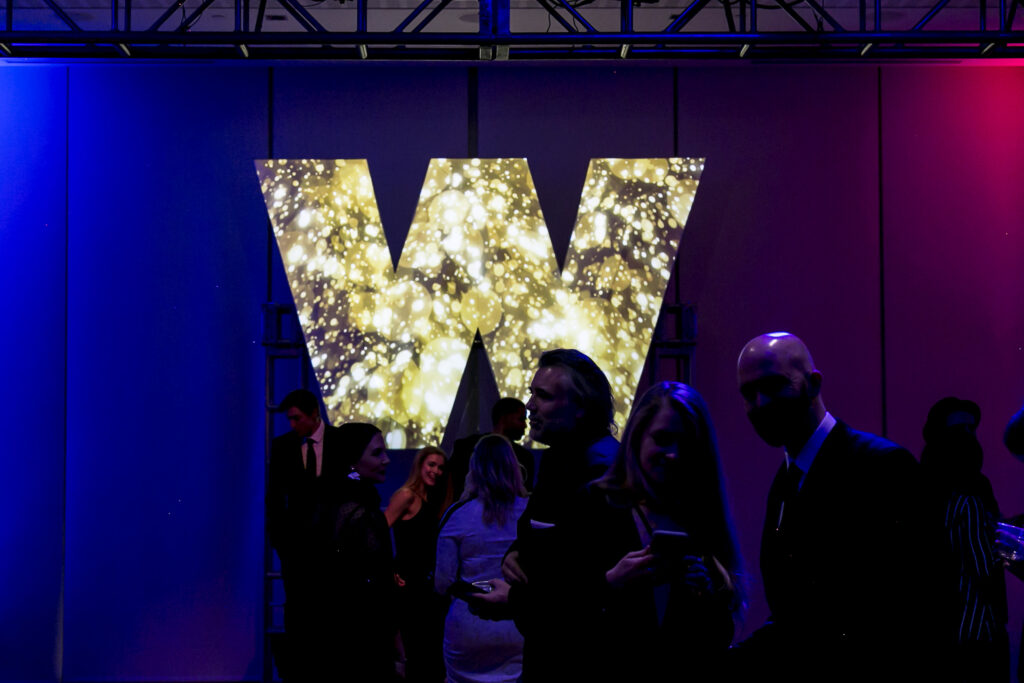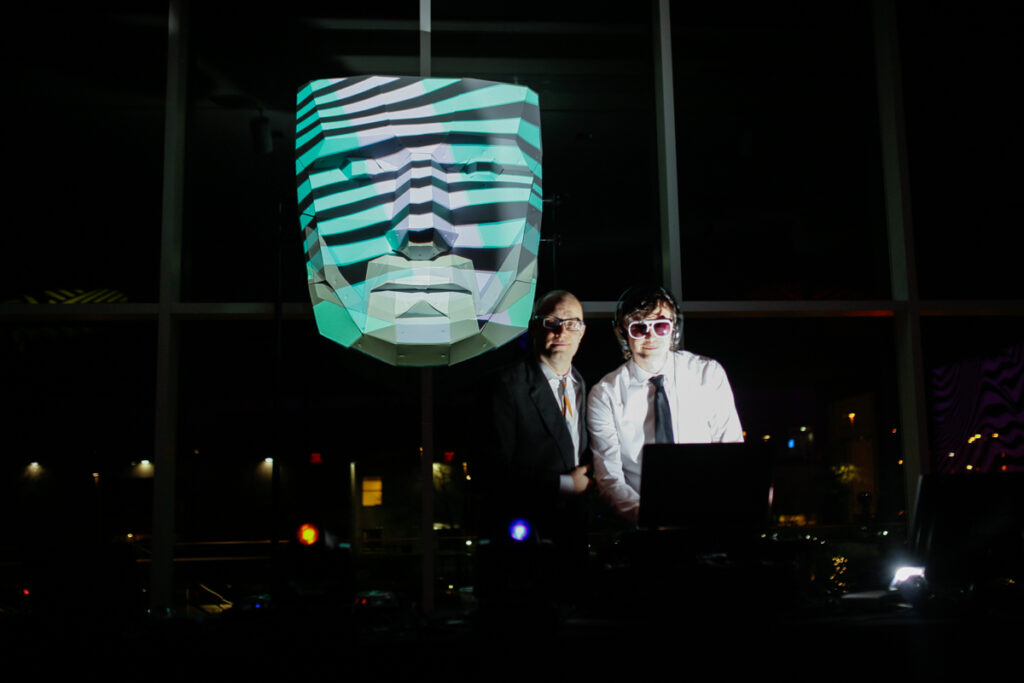
Charles and Donnie at Wonderball 2018, photo by Nathan Ward
The dance music and mapped imagery that plays in the Schottenstein Property Group Pavilion during Wonderball events is a favorite feature for attendees. An element that has been there since day one, but has evolved and expanded year after year, embodying new themes and stretching the boundaries of creativity.
The team behind Wonderball’s visual animations and DJ sets are Charles Erickson and Donnie Mossman of Pacemour Creative, a Columbus agency that specializes in 3D projection mapping and event-based visuals. Starting as DJs and expanding to become designers, Erickson and Mossman have an undying love for music.
“Music has always been foundational,” explains Mossman. “I’ve played in bands since I was 15. My life has always been about music.” He grew up in a musical family in Northern Ohio with parents who traveled and performed in bands before settling down as a music therapist and owner of a music store.
It was his early experiences playing in a band that propelled Mossman to animation. Looking to heighten their stage presence, he began to pair audio loops and visuals. His creativity quickly progressed and outpaced available content so he jumped into building animations from scratch.
“I learned new programs and formats which segued into projection mapping and making various light art pieces,” he explained.
While Erickson didn’t have musical parents, music still ran through his veins. He grew up in Minneapolis with an incredibly rich culture and musical community. He had opportunities to work and interact with notable musicians that influenced his career progression and early work with record labels. Similar to Mossman, when working as a DJ he saw a need to enhance the experience with art. “Music is a passion. Incorporating visual art and marrying them together has been the greatest joy,” he adds.
But it wasn’t until the first Wonderball event that they began to stretch the envelope with their capabilities. Brought on for their musical talent they quickly expanded their influence to incorporate visuals and are now an integral part of the annual event. While their company Pacemour was officially launched in 2018, Erickson and Mossman’s partnership bloomed when they began working with the Columbus Museum of Art in 2015.
“When you’re curating both [music and visuals] together you set the tone and vibe for an event. You’re covering two senses and they are collaborating and matching with one another,” said Mossman.
With that in mind, you might say the duo is responsible for setting the tone of past Wonderball celebrations. So where will they take us in 2021? In the spirit of the personal evolutions that have molded our lives in the last year, Erickson and Mossman built animations and playlists that shapeshift, melt, and rebuild.
When describing this year’s visuals, Erickson says that “You’ll see that in the visuals that accompany DJ sets, many of the animated elements react directly to the beats of the songs. This was a departure for us, different from our normal process. We were able to make specific scenes for the pre-recorded DJ sets, which allowed them to be sound reactive and more deliberately influenced by the music, not just complimentary.”
“We had a lot of free time during the early days of the shutdown,” adds Mossman. “We tried new techniques and learned new things. It came in handy. This year we’re employing new work that we haven’t used before.”
In anticipation for Wonderball 2021, we connected further with the duo to get their thoughts on collaborating with CMA, adapting to change and being part of Wonderball since its inception.

Wonderball 2020 visual, photo by Nikole Breanna Prete
How have the event visuals adapted in the last year to fit virtual events?
Charles: Our event visuals are composed of original animated video content. That content is created with the display parameters in mind, especially since they are typically projection mapped onto a three-dimensional object or a uniquely-shaped surface. This year the presentation is formatted for home viewing so the focus was not about how the visuals fit into a physical space, but instead it was how they work as transitions between the filmed artistic performances. They are a bit more brand-focused, more W’s and less abstract shapes.
Donnie: In the past we’ve always made large projection mapping pieces that live in the main event space at the museum. Since this year will be 100% virtual we decided to use green screen to allow for visuals to be incorporated behind the performers. This way we could customize the visuals to the music and make them fit the aesthetic of each performer. We also animated some transitions that will bookend the live streamed segments and provide a little eye candy for the viewers.
How has your relationship with Wonderball evolved since the event started?
Donnie: We’ve definitely gone bigger and bolder each year, always trying to set the bar higher. The first year was a simple single projector setup with a basic screen for visuals and since then every year has had larger and more immersive installations to transform the space as much as possible. I think the event has really done a great job of fostering creativity in it’s participants and performers; we look forward to it every year.
Charles: As Donnie said, in one sense our relationship with Wonderball was defined by the drive to continually improve upon whatever we created the previous year. First it was creating the largest size projection: mapping all of the windows in 2018, then creating a continuous screen that wrapped over 180 degrees from one side of the room to the other in 2019. Last year we made our largest and most complex 3D structure yet with a giant contoured letter W that was over 11 feet wide and taller than either of us.
That said, the virtual event has reminded us that our relationship has overall stayed very simple. We have been a part of every Wonderball event so far, making us part of a small family. I would say that the relationship has not evolved so much as it has just strengthened and deepened over time.
How has the Columbus art community risen to the occasion around COVID-19 impacts?
Donnie: The community reacted quickly with relief grants for all the artists whose incomes were affected by the shut-down which helped a lot of people I know. I think we’ve also seen some amazing personal growth and collaboration this past year, a lot of artists trying new things and working in new ways, of course making things accessible online. I also saw artists helping with their art, everything from masks to murals. We tried to do our part by donating branding and promos for Service!, a relief effort to feed hospitality workers who were out of a job.
Charles: We supported several initiatives through our company, Pacemour Creative. Among them, Service! (servicerelief.org) was a favorite project of ours – one which we continue to support into 2021.
How do you pick visuals to match Wonderball themes? (2020 = fashion, 2021 = evolve, etc.)
Charles: Since we build the animated content with the theme in mind, it’s easy to see how those themes drive the creative process and define the results. A lot of the content you will see in this year’s virtual edition evolves very deliberately: pieces move, particles amass into place, all to form a letter W or some other object… lines distort, objects shatter, shapes are revealed, etc. Nothing really stays the same.
Donnie: We always try to think of creative ways to interpret the theme, for example we used the trending colors in the fashion industry for 2020’s theme. This year we did our best to evolve the “W” that has come to be a symbol of the event. A crystal W last year, a crystal W that breaks apart with rainbow refractions this year etc. In the DJ set visuals we created you can see new animations as well as previous year’s content that we upgraded to make them more sound reactive and synced to the music. For all of 2021’s animations and visuals we wanted them to feel familiar from years past but with new tweaks and adaptations to take them further down the rabbit hole.

Wonderball 2016, Photo by Nathan Ward
Wonderball, CMA’s annual celebration of wonder, creativity, and black and white fashion will be held virtually on January 30, 2021. Registration is free and open to the public. Donations are welcome and will support CMA’s community arts programs.
Listen to a playlist inspired by Wonderball and created by Donnie and Charles.
Charles Erickson & Donnie Mossman have provided audio & visual content for Wonderball every year since 2015. Learn more about them and their company, Pacemour Creative, by visiting pacemour.com
Written by Bethany Cramer – digital marketing and public relations professional and five-year member of the CMA Wonderball marketing committee. She is an ambassador for creativity in Columbus, a life-long learner and SUNY Geneseo alumni.
